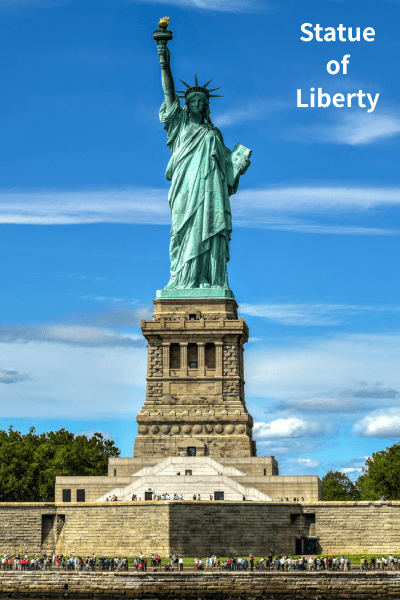
Statue of Liberty and Granite Stone
Share
The Stone Beneath Freedom — Why Granite Was Chosen
Between the 1870s and 1886, the United States received the Statue of Liberty from France as a symbol of friendship and freedom. While the colossal figure was made of copper and iron, its foundation was entrusted to one of Earth’s most enduring materials — granite. The pedestal stone was quarried from Stony Creek, Connecticut, known for its pinkish-gray tone and remarkable resistance to wind and sea air. Beyond engineering, the choice carried meaning: granite stood for permanence, trust, and the bedrock of a nation.
Design and Structure of the Pedestal
The pedestal was designed by Richard Morris Hunt and built between 1881 and 1886. Its exterior is composed of carefully cut granite blocks, and its inner core is reinforced with concrete. The combination allowed the structure to bear the statue’s immense weight — approximately 225 tons — while maintaining elegance and stability against Atlantic winds.
| Component | Material | Properties / Purpose |
|---|---|---|
| Exterior pedestal | Stony Creek granite (Connecticut) | High compressive strength, fine texture, long-term weather resistance. |
| Inner structure | Concrete | Internal stability and pressure distribution. |
| Statue body | Copper sheets with iron framework (designed by Gustave Eiffel) | Light yet strong; expressive form. |
Why Granite, Not Other Stone
By the late 19th century, America had entered the “age of steel,” yet its architects still turned to stone for what steel could not provide — symbolic endurance. Granite was the natural choice: harder than marble, resistant to acid rain, and capable of being polished to a quiet brilliance. In both Europe and America, it had become the preferred material for government buildings, courthouses, and national monuments — the literal foundation of democracy.
World Heritage Facts & Visitor Numbers
| Official name | Statue of Liberty |
|---|---|
| Inscription year | 1984 |
| UNESCO ID | 307 |
| Criteria | Cultural (i), (vi) i = a masterpiece of human creative genius vi = a universal symbol of liberty and human rights |
| Annual visitors | ~3.7 million (2023, NPS data) |
| Managing authority | U.S. National Park Service (NPS) |
| Conservation issues | Surface weathering of granite, salt air corrosion, copper oxidation, and tourism impact. |
Statue of Liberty Timeline
| Year | Event | Details |
|---|---|---|
| 1865 | Concept proposed | By French jurist and politician Édouard René de Laboulaye, as a gift symbolizing freedom and friendship between France and the United States. |
| 1870 | Sculptor appointed | Frédéric Auguste Bartholdi begins design of the statue. |
| 1875 | Fundraising begins in France | Public donations launch the project’s construction. |
| 1876 | Arm and torch completed | Displayed at the Philadelphia Centennial Exhibition. |
| 1877 | Site selected | Bedloe’s Island (now Liberty Island) designated as installation site. |
| 1879 | Internal structure design | Gustave Eiffel creates the internal iron framework. |
| 1881 | Pedestal construction begins | Designed by Richard Morris Hunt; made of Stony Creek granite from Connecticut. |
| 1884 | Statue completed in France | Disassembled and shipped to the United States. |
| 1885 | Arrival in New York | 214 crates transported aboard the French ship Isère. |
| 1886 | Official dedication | Unveiled on October 28; a gift from the French people. |
| 1906 | Patina transformation | Copper oxidized, producing the current green surface. |
| 1924 | National Monument designation | Placed under federal protection. |
| 1933 | Transferred to NPS | Management standardized under the National Park Service. |
| 1956 | Island renamed | Bedloe’s Island officially renamed Liberty Island. |
| 1984 | UNESCO World Heritage inscription | Recognized for universal value as a symbol of liberty (Criteria i, vi). |
| 1986 | Centennial restoration | New stainless steel armature and gold-leaf torch. |
| 2001 | Temporary closure after 9/11 | Security restrictions implemented. |
| 2004 | Pedestal reopens | Structural inspection completed; public access restored. |
| 2012 | Hurricane Sandy damage | Island flooded; reopened in 2013 after repairs. |
| 2019 | Statue of Liberty Museum opens | Designed by FXCollaborative; showcases statue history and materials. |
The Endurance of Stone and the Color of Memory
The Statue of Liberty’s message of freedom is not only carried by her torch of light but grounded in the quiet endurance of granite. Without this stone foundation, the monument could not have withstood 135 years of wind, salt, and time. Granite, unseen yet essential, remains the silent architecture of ideals.
Explore Related Japanese Stone Craft
Last updated: October 2025 (JST)

